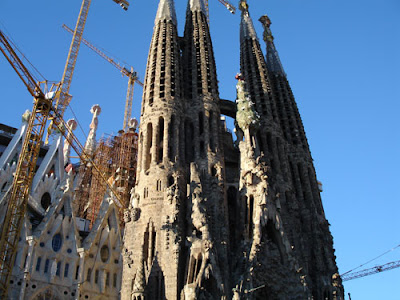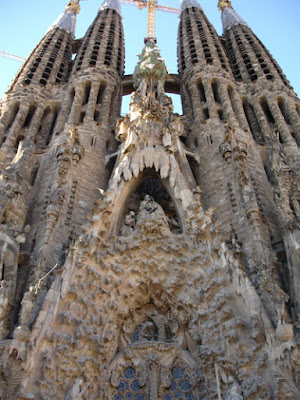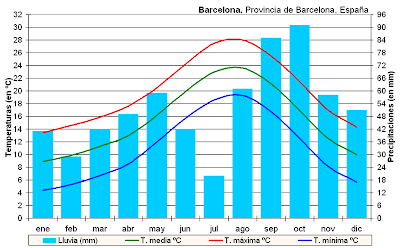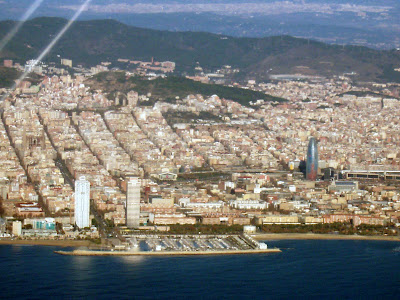The Sagrada Familia (Holy Family) is a church in Barcelona, Spain. This gigantic church in the so called neocatalan style and Catalan modernism is overloaded with towers and ornaments. People have been building for a long time on the church. So long, that the complete parts already need renovation. Many people think that all the work will never be completed.
The architect who designed the Sagrada Familia is Antoni Gaudí, the designer of more other characteristic buildings in Barcelona (like Casa Battló and Parc Guëll).
Originally the church was a classic neogothic church by design of Francisco de Paula del Villar. But after one year, in 1883, Gaudí was assigned to be responsible for the design and building of the Sagrada Familia. He changed the original plans of the building dramatically and started building the church in his own excentric style. The building is full of Christian symbolism.
There was so much work to do on the Sagrada Familia that Antoni Gaudí didn't have time for other assignments. He dedicated the last years of his life to the Sagrada Familia. When he accidentily came under a tram in 1926 and died, he got buried in the crypt of his own masterpiece.
The Sagrada Familia, (a Catholic church) is the masterpiece of Gaudí. This temple is by now the symbol of modernistic architecture in Barcelona. During the building of the Sagrada Familia, Gaudí insisted that he knew everything about the construction of the church. He teached the workers by himself, looked after all details and kept changing his ideas until the style wasn't Gothic anymore.
Sagrada Familia - The beginning
The idea to build the Sagrada Familia came from a bookseller called Joseph María Bocabella. He did this to keep the keep remembering the people of the Catholic religion. After a lot of donations Bocabella bought a piece of land of 12.800 square meters. The architect Francisco de Paula del Villar offered Bocabella to make plans for the Sagrada Familia for free. His design became totally neogothic.

Del Villar started with the construction of the crypt but after a year he got into a fight with Bocabella and got fired. Afterwards Gaudí got the assignment via Juan Martorell. He finished the crypt like the ideas of del Villar, but gave his own twist on it. Gaudí made a lot of maquettes to work out all the fine details that the design of the Sagrada Familia has.
Sagrada Familia - Details
Every part of the Sagrada Familia has it's own theme. The west part of the church, the facade of the Passion, is about the suffering of Jesus Christ and is designed with many edgy sculptures. The eastern facade is about the birth of Jesus Christ.

There is many decoration on the church, like the three portals: "Fe", "Esperanca" and "Caridad" (faith, hope and love). If the construction is finished, the Sagrada Familia will be the biggest church of the whole world.
The tops of the different towers are probably inspired by the cubism and the decorations probably by the style called Art Nouveau.
Sagrada Familia - The finance
The Sagrada Familia is only funded by donations, which is also a reason why the construction is taking so long. From the eightees on the construction of the Sagrada Familia is also being financed by entrance money. Because the Sagrada Familia has many visits every day, the construction goes faster then before. In the beginning there were only two people working on the Sagrada Familia. Nowadays, there are about a hundred people working on the Sagrada Familia, including fifteen architects.
Sagrada Familia - The duration of the construction
In 1881 Francesco de Paula del Villar got the assignment to build the Sagrada Familia, which was handed over to Gaudí in 1883. Originally, Antoni Gaudí thought he was able to finish the construction of the Sagrada Familia within ten years. Altough, in a few years Gaudí found out that it was impossible to finish the construction in that short amount of time. That's why he made a lot of maquettes and drawings of the Sagrada Familia.
When Gaudí died in 1926, there was enough work for other architects to continue with. After that, the workshop of Gaudí set fire, and a lot of models and drawings of Gaudí set fire as well.
It is expected that the construction of the Sagrada Familia will be finished around 2025.
Click here for the official website of the Sagrada Familia.







